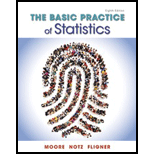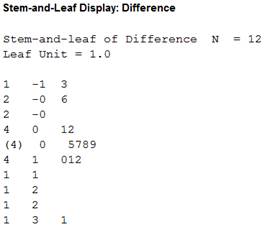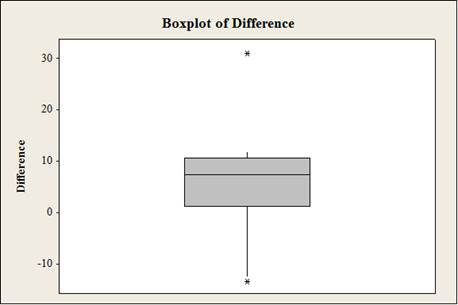
a.
To explain: Matched pairs design.
a.
Answer to Problem 20.33E
The newt’s ability to heal in one leg depends on the newt’s ability to heal in another leg. Moreover, the two hind limbs namely, control limb and experimental limb are matched by newt.
Explanation of Solution
Given info:
In the experiment, the two hind limbs of 12 newts were assigned at random to either experimental or control group.
Justification:
Matched pairs:
If the sample values from one population are associated or matched with the sample values from another population, then the two samples are said to be matched pairs or dependent samples.
Matched pair design occurs at two situations, which are listed below:
- Subjects are matched with pairs and each treatment is given to one subject in each pair
- Before and after observations on the same subjects.
In the given experiment, the newt’s ability to heal in one leg depends on the newt’s ability to heal in another leg. This indicates that the samples are not independent. Thus, the two hind limbs namely, control limb and experimental limb are matched by newt.
b.
To construct: The stemplot of the differences between limbs of the same newt and also to check whether there is a high outlier or not.
b.
Answer to Problem 20.33E
Output using the MINITAB software is given below:

The stemplot plot clearly establishes the extreme outlier mentioned in the question.
Explanation of Solution
Calculation:
Software procedure:
Step-by-step procedure to construct the stemplot using the MINITAB software:
- Select Graph > Stem and leaf.
- In Graph variables, select Difference.
- Select OK
Interpretation:
There is sign of a major deviation from normality because the shape of the distribution is not a bell shape. That is, the stemplot suggests that the distribution of the data is skewed to the right with an extreme outlier (31). Thus, the stemplot plot clearly establishes the extreme outlier mentioned in the question.
c.
To find: The test statistic and P value with one test including all 12 newts and another omitting the outlier.
To check: Whether the outliers have a strong influence on conclusion or not.
c.
Answer to Problem 20.33E
There is sufficient evidence to support the claim for the
When omitting the outliers from the data set, there is weaker evidence to support the claim for the mean healing rate being significantly lower in the experimental limbs.
Yes, the outliers have a strong influence on the conclusion.
Explanation of Solution
Given info:
The mean healing rate is significantly lower in the experimental limbs with one test including all 12 newts and another omitting the outlier.
Calculation:
The null and alternative hypotheses are given below:
Null hypothesis:
Alternative hypothesis:
Test statistic and P-value for original data:
Software procedure:
Step-by-step procedure to obtain the test statistic and P-value for the original data using the MINITAB software:
- Choose Stat > Basic Statistics > 1-Sample t.
- In Samples in Column, enter the column of “Difference”.
- In Perform hypothesis test, enter the test mean as 0.
- Check Options, enter Confidence level as 95.0.
- Choose greater than in alternative.
- Click OK in all dialogue boxes.
Output using the MINITAB software is given below:

Thus, the test statistic is 2.08 and the P-value is 0.031.
Decision criteria for the P-value method:
If
If
Conclusion:
Here, the P-value for the hypotheses tests is 0.031, which is less than the level of significance. That is,
Test statistic and P-value when omitting the outlier:
Software procedure:
Step-by-step procedure to obtain the test statistic and P-value when omitting the outlier using the MINITAB software:
- Choose Stat > Basic Statistics > 1-Sample t.
- In Samples in Column, enter the column of “Difference”.
- In Perform hypothesis test, enter the test mean as 0.
- Check Options, enter Confidence level as 95.0.
- Choose greater than in alternative.
- Click OK in all dialogue boxes.
Output using the MINITAB software is given below:

Thus, the test statistic is 1.79 and the P-value is 0.052.
Conclusion:
Here, the P-value for the hypotheses test is 0.052, which is greater than the level of significance. That is,
Comparison:
There is sufficient evidence to support the claim for the mean healing rate being significantly lower in the experimental limbs with all 12 differences. But, there is a weaker evidence to support the claim for the mean healing rate being significantly lower in the experimental limbs when omitting the outliers from the data set.
d.
To construct: The modified boxplot of the differences between the limbs of the same newt.
To find: The test statistic and P value with one test including all 12 newts and another omitting both the outliers.
To check: Whether the outliers have a strong influence on the conclusion or not.
To compare: The obtained test result with the result in part (c).
d.
Answer to Problem 20.33E
Output using the MINITAB software is given below:

The graph suggests the distribution of the data skewed with two outliers.
Yes, the outliers have a strong influence on the conclusion.
When omitting the two outliers from the data set, there is stronger evidence to support the claim for the mean healing rate. It is significantly lower in the experimental limbs than the result in part (c).
Explanation of Solution
Calculation:
Software procedure:
Step-by-step procedure to construct the box plot for the original data using the MINITAB software:
- Choose Graph > Boxplot or Stat > EDA > Boxplot.
- Under Single Y, choose Simple. Click OK.
- In Graph variables, enter the data of Newts.
- Click OK.
Graph interpretation:
The boxplot suggests that the distribution of the data skewed with two extreme outliers (–13 and 31).
Test statistic and P-value after omitting the outliers:
Software procedure:
Step-by-step procedure to obtain the test statistic and P-value when omitting the outliers using the MINITAB software:
- Choose Stat > Basic Statistics > 1-Sample t.
- In Samples in Column, enter the column of “Difference”.
- In Perform hypothesis test, enter the test mean as 0.
- Check Options, enter Confidence level as 95.0.
- Choose greater than in alternative.
- Click OK in all dialogue boxes.
Output using the MINITAB software is given below:

Thus, the test statistic is 3.36 and the P-value is 0.004.
Conclusion:
Here, the P-value for the hypotheses test is 0.004, which is less than the level of significance. That is,
Comparison:
There is strong evidence to support the claim for the mean healing rate being significantly lower in the experimental limbs after omitting the outliers from the data set when compared to the result in part (c).
Want to see more full solutions like this?
Chapter 20 Solutions
The Basic Practice of Statistics
- An article in Business Week discussed the large spread between the federal funds rate and the average credit card rate. The table below is a frequency distribution of the credit card rate charged by the top 100 issuers. Credit Card Rates Credit Card Rate Frequency 18% -23% 19 17% -17.9% 16 16% -16.9% 31 15% -15.9% 26 14% -14.9% Copy Data 8 Step 1 of 2: Calculate the average credit card rate charged by the top 100 issuers based on the frequency distribution. Round your answer to two decimal places.arrow_forwardPlease could you check my answersarrow_forwardLet Y₁, Y2,, Yy be random variables from an Exponential distribution with unknown mean 0. Let Ô be the maximum likelihood estimates for 0. The probability density function of y; is given by P(Yi; 0) = 0, yi≥ 0. The maximum likelihood estimate is given as follows: Select one: = n Σ19 1 Σ19 n-1 Σ19: n² Σ1arrow_forward
- Please could you help me answer parts d and e. Thanksarrow_forwardWhen fitting the model E[Y] = Bo+B1x1,i + B2x2; to a set of n = 25 observations, the following results were obtained using the general linear model notation: and 25 219 10232 551 XTX = 219 10232 3055 133899 133899 6725688, XTY 7361 337051 (XX)-- 0.1132 -0.0044 -0.00008 -0.0044 0.0027 -0.00004 -0.00008 -0.00004 0.00000129, Construct a multiple linear regression model Yin terms of the explanatory variables 1,i, x2,i- a) What is the value of the least squares estimate of the regression coefficient for 1,+? Give your answer correct to 3 decimal places. B1 b) Given that SSR = 5550, and SST=5784. Calculate the value of the MSg correct to 2 decimal places. c) What is the F statistics for this model correct to 2 decimal places?arrow_forwardCalculate the sample mean and sample variance for the following frequency distribution of heart rates for a sample of American adults. If necessary, round to one more decimal place than the largest number of decimal places given in the data. Heart Rates in Beats per Minute Class Frequency 51-58 5 59-66 8 67-74 9 75-82 7 83-90 8arrow_forward
- can someone solvearrow_forwardQUAT6221wA1 Accessibility Mode Immersiv Q.1.2 Match the definition in column X with the correct term in column Y. Two marks will be awarded for each correct answer. (20) COLUMN X Q.1.2.1 COLUMN Y Condenses sample data into a few summary A. Statistics measures Q.1.2.2 The collection of all possible observations that exist for the random variable under study. B. Descriptive statistics Q.1.2.3 Describes a characteristic of a sample. C. Ordinal-scaled data Q.1.2.4 The actual values or outcomes are recorded on a random variable. D. Inferential statistics 0.1.2.5 Categorical data, where the categories have an implied ranking. E. Data Q.1.2.6 A set of mathematically based tools & techniques that transform raw data into F. Statistical modelling information to support effective decision- making. 45 Q Search 28 # 00 8 LO 1 f F10 Prise 11+arrow_forwardStudents - Term 1 - Def X W QUAT6221wA1.docx X C Chat - Learn with Chegg | Cheg X | + w:/r/sites/TertiaryStudents/_layouts/15/Doc.aspx?sourcedoc=%7B2759DFAB-EA5E-4526-9991-9087A973B894% QUAT6221wA1 Accessibility Mode பg Immer The following table indicates the unit prices (in Rands) and quantities of three consumer products to be held in a supermarket warehouse in Lenasia over the time period from April to July 2025. APRIL 2025 JULY 2025 PRODUCT Unit Price (po) Quantity (q0)) Unit Price (p₁) Quantity (q1) Mineral Water R23.70 403 R25.70 423 H&S Shampoo R77.00 922 R79.40 899 Toilet Paper R106.50 725 R104.70 730 The Independent Institute of Education (Pty) Ltd 2025 Q Search L W f Page 7 of 9arrow_forward
- COM WIth Chegg Cheg x + w:/r/sites/TertiaryStudents/_layouts/15/Doc.aspx?sourcedoc=%7B2759DFAB-EA5E-4526-9991-9087A973B894%. QUAT6221wA1 Accessibility Mode Immersi The following table indicates the unit prices (in Rands) and quantities of three meals sold every year by a small restaurant over the years 2023 and 2025. 2023 2025 MEAL Unit Price (po) Quantity (q0)) Unit Price (P₁) Quantity (q₁) Lasagne R125 1055 R145 1125 Pizza R110 2115 R130 2195 Pasta R95 1950 R120 2250 Q.2.1 Using 2023 as the base year, compute the individual price relatives in 2025 for (10) lasagne and pasta. Interpret each of your answers. 0.2.2 Using 2023 as the base year, compute the Laspeyres price index for all of the meals (8) for 2025. Interpret your answer. Q.2.3 Using 2023 as the base year, compute the Paasche price index for all of the meals (7) for 2025. Interpret your answer. Q Search L O W Larrow_forwardQUAI6221wA1.docx X + int.com/:w:/r/sites/TertiaryStudents/_layouts/15/Doc.aspx?sourcedoc=%7B2759DFAB-EA5E-4526-9991-9087A973B894%7 26 QUAT6221wA1 Q.1.1.8 One advantage of primary data is that: (1) It is low quality (2) It is irrelevant to the purpose at hand (3) It is time-consuming to collect (4) None of the other options Accessibility Mode Immersive R Q.1.1.9 A sample of fifteen apples is selected from an orchard. We would refer to one of these apples as: (2) ھا (1) A parameter (2) A descriptive statistic (3) A statistical model A sampling unit Q.1.1.10 Categorical data, where the categories do not have implied ranking, is referred to as: (2) Search D (2) 1+ PrtSc Insert Delete F8 F10 F11 F12 Backspace 10 ENG USarrow_forwardepoint.com/:w:/r/sites/TertiaryStudents/_layouts/15/Doc.aspx?sourcedoc=%7B2759DFAB-EA5E-4526-9991-9087A 23;24; 25 R QUAT6221WA1 Accessibility Mode DE 2025 Q.1.1.4 Data obtained from outside an organisation is referred to as: (2) 45 (1) Outside data (2) External data (3) Primary data (4) Secondary data Q.1.1.5 Amongst other disadvantages, which type of data may not be problem-specific and/or may be out of date? W (2) E (1) Ordinal scaled data (2) Ratio scaled data (3) Quantitative, continuous data (4) None of the other options Search F8 F10 PrtSc Insert F11 F12 0 + /1 Backspaarrow_forward
 MATLAB: An Introduction with ApplicationsStatisticsISBN:9781119256830Author:Amos GilatPublisher:John Wiley & Sons Inc
MATLAB: An Introduction with ApplicationsStatisticsISBN:9781119256830Author:Amos GilatPublisher:John Wiley & Sons Inc Probability and Statistics for Engineering and th...StatisticsISBN:9781305251809Author:Jay L. DevorePublisher:Cengage Learning
Probability and Statistics for Engineering and th...StatisticsISBN:9781305251809Author:Jay L. DevorePublisher:Cengage Learning Statistics for The Behavioral Sciences (MindTap C...StatisticsISBN:9781305504912Author:Frederick J Gravetter, Larry B. WallnauPublisher:Cengage Learning
Statistics for The Behavioral Sciences (MindTap C...StatisticsISBN:9781305504912Author:Frederick J Gravetter, Larry B. WallnauPublisher:Cengage Learning Elementary Statistics: Picturing the World (7th E...StatisticsISBN:9780134683416Author:Ron Larson, Betsy FarberPublisher:PEARSON
Elementary Statistics: Picturing the World (7th E...StatisticsISBN:9780134683416Author:Ron Larson, Betsy FarberPublisher:PEARSON The Basic Practice of StatisticsStatisticsISBN:9781319042578Author:David S. Moore, William I. Notz, Michael A. FlignerPublisher:W. H. Freeman
The Basic Practice of StatisticsStatisticsISBN:9781319042578Author:David S. Moore, William I. Notz, Michael A. FlignerPublisher:W. H. Freeman Introduction to the Practice of StatisticsStatisticsISBN:9781319013387Author:David S. Moore, George P. McCabe, Bruce A. CraigPublisher:W. H. Freeman
Introduction to the Practice of StatisticsStatisticsISBN:9781319013387Author:David S. Moore, George P. McCabe, Bruce A. CraigPublisher:W. H. Freeman





